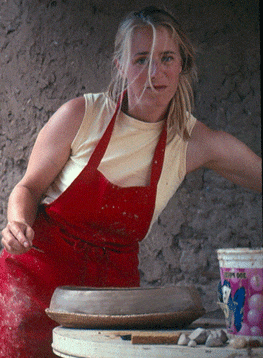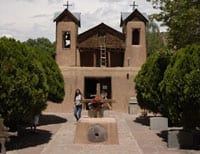SMU archaeologist Sunday Eiselt leads the SMU-in-Taos Childhood Archaeology Project, a systematic and scientific examination of children’s lives through a community archaeological excavation project in the historic and picturesque plaza of Ranchos de Taos in northern New Mexico.
Journalist Julian Smith wrote about Eiselt’s research in the May/June edition of Archaeology magazine.
 |
| Sunday Eiselt |
The research will provide new perspectives on the dynamics of Spanish and American occupation of New Mexico, says Eiselt, an SMU anthropology professor in SMU’s Dedman College. The plaza was once a hub of village life in Ranchos de Taos. But these days it’s notably absent of children. Their families have been driven to the outskirts of the Catholic village by a booming tourism industry that has pushed up property values.
Still, the children who lived there in decades past left their mark, says Eiselt, who for three years has led digging crews in some of the homes through her work in the SMU Archaeology Field School at the SMU-in-Taos campus. The crews have unearthed children’s artifacts up to 100 years old, including pieces of clay toys, tea sets, doll parts, clothing, mechanical trains, jacks, marbles, child-care implements, modern plastic Legos, Barbie doll parts, action figures and jewelry.
Eiselt’s pilot excavations in 2007 and 2008 revealed patterns that suggest children were integral to the workforce and household economy in the 18th and 19th centuries. In the 1930s, the evidence shows, they were drawn from the workforce into the home and pulled as a consumer into the expanding commercial market as well as into the public education realm, Eiselt says.
Her interest in childhood artifacts is unique because children are rarely documented in archaeological narratives — particularly in the Spanish borderlands, where they appear as victims of slavery and boarding schools.
Eiselt specializes in the historical archaeology of native people of the Southwest.
EXCERPT
Excavated toys and games reflect the changing experience of childhood in New Mexico
By Julian Smith
The full moon casts a warm glow across the dirt plaza of Ranchos de Taos and the adobe walls of the church of Saint Francis of Assisi, made famous by the paintings of Georgia O’Keeffe.Inside the parish hall, archaeologist Sunday Eiselt of Southern Methodist University (SMU) faces a small crowd. She’s a little nervous. Eiselt is about to ask the residents of this conservative Hispanic community near Taos, New Mexico, for permission to dig up their backyards and the floors of their centuries-old homes. Today, the area is known as a ski town and a magnet for both the super-rich and hippie artists, but the community was founded in the 17th century, and is one of the oldest in the country.
Read the full online version. (A more complete story appears in the printed version.)
Related links:
Sunday Eiselt and her research
Sunday Eiselt brief bio
SMU’s Archaeology Field School
SMU-in-Taos
Taos Collaborative Archaeology Project
SMU’s Department of Anthropology
Dedman College of Humanities and Sciences
 SMU archaeologist Sunday Eiselt leads the SMU-in-Taos
SMU archaeologist Sunday Eiselt leads the SMU-in-Taos